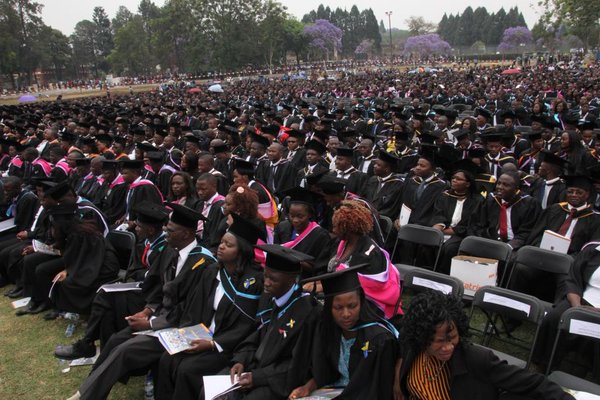Zimbabweans generally debate the quality of the national education system, with hardly any consensus on its ranking.
But the World Economic Forum (WEF), which convenes one of the most high profiles annual conferences globally, ranks Zimbabwe among five countries in Africa with some of the best education systems on the continent. The top five are Mauritius, Mozambique, Namibia, Zambia and Zimbabwe, according to its latest annual report.
The WEF included 17 African nations in its rankings in 2023 compared to nine in 2018 and just two in 2012.
The United Nations Educational, Scientific and Cultural Organisation (UNESCO) put Zimbabwe’s adult literacy rate at 89.70 percent in 2022, an increase of 5.11 percent from 2011.
In 2024, the United Nations International Day of Education, marked annually on January 24, was built around the theme: “learning for lasting peace”.
The day was earmarked by the UN General Assembly in 2018 to celebrate the role that education plays in peace and development.
The Zimbabwe Education System
The Zimbabwean education system is made up of two years of pre-primary school – referred to as Early Childhood Development (ECD), which is offered to children from the age of 3 to 5 years – seven years of primary school and four to six years of secondary education, followed by higher education in the college and university system.
The Zimbabwe school system consists of:
- 9 years of elementary school
- 4 years of junior high school
- 2 years of senior high school and
- 4 years of university and more for post – graduate education.
Early Childhood Development (ECD)
ECD ‘A’ and ECD ‘B’ is for the 3–4-year-olds and 4–5-year-olds respectively. The government has a policy which incorporates ECD into the primary education cycle for 2 years. To this end the policy stipulates that at least 2 ECD classes should be attached to every primary school. Ninety eight percent of Primary Schools are offering ECD classes.
Primary Education
Currently Primary education is a seven-year cycle and the official entry age is six years. This programme espouses the policy of compulsory education and automatic promotion from one level to the other. There is a national examination at the end of primary education cycle. Due to the shortage of secondary schools in some disadvantaged areas and the inability to raise the required school fees by some parents, the national examination becomes terminal to about 30 percent of the pupils at the Grade seven level.
Secondary Education
Secondary education in Zimbabwe comprises a four-year General Certificate of Education, (Ordinary Level). The official age for entry into Form One is 13 years. Every Grade 7 pupil is expected to graduate to Form One. There is automatic progression from Form one to Form four. Zimbabwe inherited the British system of education. Students sit for the General Certificate of Education, Ordinary Level at the end of four years of secondary education. This examination is equivalent to the Cambridge University General Certificate at ordinary level where it emanated from.
After ‘O’ Level, students who succeed can proceed to do a two-year General Certificate of Education Advanced Level cycle. Progression is on merit and the number of A Level places are limited. General Certificate of Education (Advanced Level) examination is the entry requirement for pupils into university. However, Zimbabwean students are accepted into universities outside Zimbabwe on the strength of their General Certificate of Education – Ordinary Level examination results. Those who pass ‘O’ Level but fail to proceed to do ‘A’ Level can do any of the following, among others: Teacher education, Nursing and Polytechnic education.
Tertiary Education
Tertiary Education in Zimbabwe comprises a multiplicity of programmes offered in different types of institutions that include technical and vocational training colleges, teacher training colleges and universities. The duration of these programmes varies. In Zimbabwe, entry into university is generally for those who would have successfully completed their ‘A’ Levels. The duration of the undergraduate degree programmes is usually four years, although there are some programmes that last longer like applied sciences. The Universities also offer postgraduate degrees at masters and doctoral level.
Education Regulations in Zimbabwe
There are a number of statutory bodies that monitor and regulate the provision of higher education in Zimbabwe. These bodies address various issues including quality assurance, identification of training and research needs, representation of lecturing staff and monitoring occupational standards.
Education Amendment Act
The Act came into force in May 2020 and seeks to amend the Education Act (Chapter 25:04) (“Principal Act”) by bringing it in line with the constitutional provision on education and international practice as stipulated in the African Charter and the Convention on the Rights of the Child.
The amendment protects marginalised children by promoting inclusive and equitable education specifically the girl child who is vulnerable. The Act addresses issues pertinent to girls and education, including the prohibition of expelling pregnant girls from school, free and compulsory education and sexual and reproductive health issues.
Access to sexual and reproductive health services
Section 3 amends section 4 of the Principal Act (“Children’s fundamental right to education in Zimbabwe”) by inserting subsection (1a) which states that “The State shall ensure the provision of sanitary wear and other menstrual health facilities to girls in all schools to promote menstrual health.”
This means that local schools are required to assist girls in sanitary wear and should have adequate, clean menstrual health facilities which should include clean water and sanitation.
Therefore, no girl should be forced to miss school during their menstrual period. In addition, the Act also provides for the appointment of sexual and reproductive health personnel at every school. This is important as it enables the integration of the sexual reproductive and health rights of girls in schools and by improving the teaching and understanding of the subject at schools, given the rise in the risk of violations of sexual reproductive and health rights.
Free and compulsory education
Section 4 repeals Section 5 (“Compulsory education”), of the principal Act and states that “Every child shall be entitled to compulsory basic state-funded education.”
The amendment further makes it an offence for a parent or guardian to deprive from going to school. This is an offence that can attract prison time for up to two (2) years.
This benefits girls because in disadvantaged communities’ girls are forced to drop out of school because of money and later forced into marriages to benefit their families. This amendment protects girls by ensuring that they stay in school despite any financial circumstances.
Expulsion of pregnant learners
A new section is added to the Principal Act, section 68C, which states that no child shall be excluded from school on the basis of pregnancy.
This means pregnancy cannot affect the decision to admit, suspend or expel a girl. This promotes the prevalence of girls dropping out of school because of pregnancy and the provision is commendable because there was an increase in teenage pregnancy during the Covid-19 lockdown therefore the Act ensures that these pregnant girls have access to education.
Sexual abuse regulations
Section 15 of the Act amends section 69(“Regulations”) of the principal Act by adding paragraph (n4) which states that the Minister may make regulations to manage sexual abuse cases in schools. As schools are seen as “safe spaces” for children this amendment is good in that girls are able to report and get help within the schools.
The amendment Act promotes the right to education for the girl child by improving access to education. It is a good start in working towards Sustainable Development Goal 4 which is inclusive and equitable quality education.
There are a number of concerns such as the availability of state resources to ensure that the government fulfils the provisions of the Act, therefore all stakeholders need to continue working together in ensuring that basic state-funded education is implemented and becomes a reality.
Education reforms in Zimbabwe
The relevance of Zimbabwe’s education system has come under immense scrutiny by educators, industrialists, policymakers, citizens and employers. Critics of the system argue that the studies are too focused on theory and altogether exclude areas of education that stimulate personal growth, patriotism, work ethic, morality and creativity and through the recent reforms the education system has changed to innovation and implementation.
The reforms aim to improve student’s results, the quality of teaching and the quality of the output that goes into the world of work. Greater emphasis is now on technical, engineering, art, mathematics and physical science.
Education 5.0
Education 5.0 is now a reality having been adopted by the Ministry of Higher and Tertiary Education, Science and Technology Development headed by Professor Amos Murwira. Zimbabwe’s state universities’ traditional tripartite mission of teaching, research and community service has been revised to align to the urgent national ambition to attain middle income status by year 2030. It is now demanded of the nation’s higher and tertiary education sector to not only: teach, research and community serve but rather to innovate and industrialise Zimbabwe. Under Education 5.0, Zimbabwe’s state universities must launch into outcomes-focused national development activities towards a competitive, modern and industrialized Zimbabwe. It is now all about problem-solving for value-creation.
Socio-Economic development by some Universities using Education 5.0
The institutions of higher and tertiary are now citadels of innovation and industrial hubs proffering solutions to communities’ problems. The Education 5.0 model has started bearing fruits as most tertiary institutions have begun to articulate the call for technological development to drive the country’s empowered upper middle-income economy.
The Lupane State University’s dryland agro-industrial park is working on improving agriculture’s production systems from subsistence to semi-intensive and intensive farming systems.
Great Zimbabwe University’s innovation centre for dryland agriculture in Chivi is advancing knowledge on traditional grain and indigenous livestock breeds.
Chinhoyi University of Technology has embarked on industrial Cattle Pens and a milking parlour to improve knowledge on artificial insemination and milk production.
National University of Science and Technology, Zimbabwe is expected to lead the country’s technological innovations that will create new industries in line with its science, technology, engineering and mathematics (STEM) mandate.
Marondera University of Agricultural Science & Technology is leading in research on the nutritional value of traditional food.
Gwanda State University’s mining engineering department is setting up a laboratory to research on recovery processes, value addition and beneficiation of all precious and semi-precious minerals.
Key milestones for Zimbabwe’s Education System
The Zimbabwe National Statistics Agency’s labour force survey estimated that 93,7% percent of people over 15 were literate in 2022. This figure is based on the percentage of people in this age group that had completed Grade 3 of schooling.
The country’s 2022 Demographic and Health Survey estimated that 95.2 percent of men aged 15 to 54 and 92.4 percent of women aged 15 to 49 were literate.
UNESCO’s Institute for Statistics estimated that 88.69 percent of Zimbabwean aged 15 and older were literate in 2022. This estimation was based on Zimbabwe’s 2022 Demographic and Health Survey results.
Sources
Ministry of Higher and Tertiary Education
United Nations Educational, Scientific and Cultural Organization
The World Economic Forum
https://www.weforum.org/agenda/2023/04/africa-universities-world-rankings-growth-summit-2023/
Veritas
Related
Do you want to use our content? Click Here












